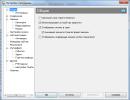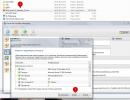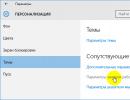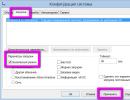Displaying the computer on the windows 10 desktop.
With new operating systems, Microsoft is trying to move away from the standard way users think about Windows. In Windows 8, the American corporation made the main screen tiled, but in Windows 10 it returned the familiar desktop. However, with all these manipulations, the familiar My Computer icon disappeared from the desktops of computers running Windows 10. There is a way to return the My Computer shortcut to the desktop in Windows 10. We suggest you familiarize yourself with it.
Return the My Computer shortcut to the desktop in Windows 10 through the Personalization menu
The Windows 10 operating system allows each computer owner to customize literally everything, from the background image to the location of mini-tiles in the Start menu. Users can also return the My Computer item through standard Windows 10 tools. The fact that the familiar shortcut is disabled by default does not indicate Microsoft’s desire to force users to abandon it completely, it just decided that it would be more convenient.
To return the My Computer shortcut to the desktop in Windows 10, you must:

After completing all the desired settings, the user will see that a standard My Computer (This Computer) shortcut, familiar from the oldest versions of Windows, has appeared on his desktop.
How to return My Computer to the Windows 10 desktop when the version of the system is not activated
Microsoft allows everyone to install the Windows 10 operating system on their computers for free. After installation, the user receives a non-activated version of the system, which can be activated by purchasing a license key. Not everyone activates Windows 10, but the trial version of the system does not have access to some functions that the user may need. In particular, on the version of Windows 10 without activation, you cannot launch the “Personalization” settings using standard methods.
To get to the “Show or hide common desktop icons” menu, you can use the Control Panel. To do this, right-click on the “Start” button and select “Control Panel” in the window that appears. In the menu that opens, at the top right in the search, write the word “Icons”, and based on the search results, click on the required item. 
There is an even easier way to get to the settings that allow you to return My Computer to the Windows 10 desktop. To do this, you need to enter a command in the “Run” menu that will immediately take you to the required settings page. To make this happen, do the following: press the Windows + R key combination on your keyboard, and in the “Run” menu bar that opens, enter the command Rundll32 shell32.dll,Control_RunDLL desk.cpl,5 to go to the “Show or hide regular desktop icons” settings item. 
To place the My Computer shortcut on the desktop in Windows 10, you need to spend literally a minute if you know where to look for the necessary settings. The described methods for a non-activated version of Windows 10 are also excellent for the activated version of the operating system, and the “Run” window is the easiest and fastest way to get to the required settings.
In this short article, I decided to show several ways how you can display your computer on the Windows 10 desktop. After all, as you know, this function is disabled by default in the operating system.
It seems that this article should have turned out to be quite simple, but it was not so. I decided to try this once in one non-activated version of Windows 10 and encountered some difficulties, which we will talk about a little later.
Well, now let's start returning "My Computer", although it is no longer mine, but "This computer", they took it away from us.
And so right-click on the desktop and select "Personalization"
In the window that opens, we need to go to the “Themes” tab and select the sub-item. Then check the box next to the “Computer” item and watch “This computer” on the desktop. You can do this now.
But personally, I suddenly started having problems on a non-activated version of the OS. Paragraph "Desktop Icon Options" was unavailable and the message was lit in red. To personalize your computer, you need to activate Windows.

We bypass this ban and get directly into "Icon Options".
To do this, press the Win+R key combination and in the window that opens, write the following command:
Rundll32 shell32.dll,Control_RunDLL desk.cpl,5

Click “OK” and we get where we need to go. We put the necessary bird there opposite “Computer”.

Returning the computer icon to the desktop using the Registry Editor
I am writing this section of the article for general development. However, if the two methods described above did not help you, then the registry will definitely solve the problem.
Press the Win+R key combination in the window that opens and write the command regedit:

We get to the registry editor. And we follow the path:
HKEY_CURRENT_USER/Software/ Microsoft/Windows/CurrentVersion/Explorer/Advanced
Find the DWORD parameter HideIcons and assign it the value 0; if there is no such parameter there, then create it by right-clicking on an empty space.

That's it, after restarting the computer we have the icon we need:

I hope I helped you solve the problem and you easily restored your computer icon to your desktop.
And also watch a video on the topic:
Rate this article:
After installing or upgrading your computer to Windows 10, the My Computer icon may be missing on your desktop (PC). Here's how to add My Computer to your Windows 10 desktop to directly access your system drives, removable drives, virtual drives, and physical drives.
In the Settings app
The easiest way to add an icon on your PC is to use the Settings application.
In Control Panel
Using Registry Editor
Using the Registry Editor is not an easy way, but if none of the options suits you, then use it (you can find out how to work with the Registry Editor in the article “Working with the Registry in Windows 10”).
Video
The video explains in more detail how to get the icon back using the Settings app and Control Panel.
Conclusion
The My Computer icon is added after reinstalling or updating the operating system. You can do this in several ways: in the Registry Editor, Control Panel, and the fastest way is in the Settings application.





